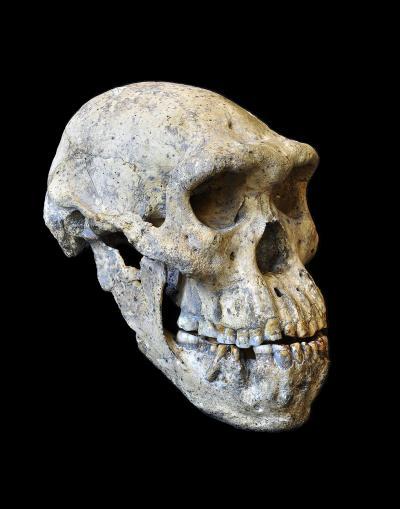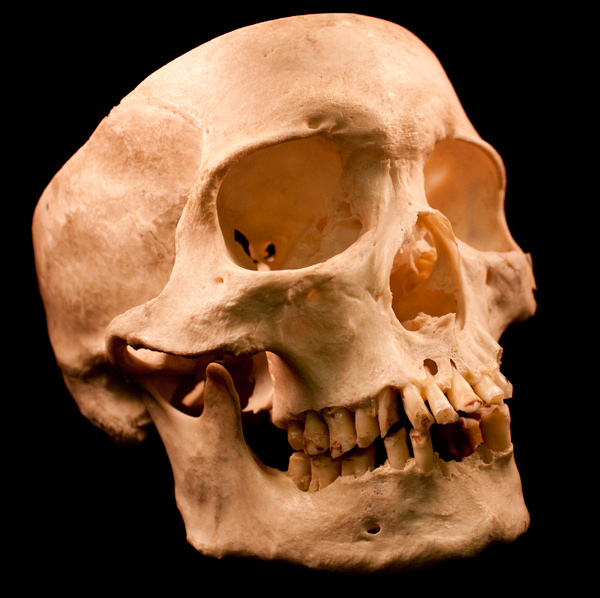The recent Science paper announcing the discovery of a complete skull from Dmanisi, Georgia has been badly misunderstood by special creationists who, misled by popular reports that claim it 'throws the story of human evolution into disarray', think that it has disproved human evolution. It hasn't.
So, what's the fuss about? Here's the skull:
Two things need to be mentioned. It's old - 1.8 million years old. It also has a small braincase, with a cranial capacity of 547 cc. Now, here's an anatomically modern human skull
The average cranial capacity for an anatomically modern human skull is between 1300 - 1500 cc. There's certainly been considerable evolutionary change over the 1.8 million year period.
Those wondering what all the fuss is about could do worse than look at the paper which is freely available. From the abstract:
The site of Dmanisi, Georgia, has yielded an impressive sample of hominid cranial and postcranial remains, documenting the presence of Homo outside Africa around 1.8 million years ago. Here we report on a new cranium from Dmanisi (D4500) that, together with its mandible (D2600), represents the world's first completely preserved adult hominid skull from the early Pleistocene. D4500/D2600 combines a small braincase (546 cubic centimeters) with a large prognathic face and exhibits close morphological affinities with the earliest known Homo fossils from Africa. The Dmanisi sample, which now comprises five crania, provides direct evidence for wide morphological variation within and among early Homo paleodemes. This implies the existence of a single evolving lineage of early Homo, with phylogeographic continuity across continents.
In other words, this skull, along with other remains discovered from Dmanisi at that time are similar in shape and size to the earliest known members of the genus Homo found in Africa, but have widespread variation in shape. Their argument is that rather than belonging to several species within the genus Homo, early humans were better classified within a single species that evolved over time. As palaeoanthropologist John Hawks notes:
The essential claim: the shape variation among these four Dmanisi crania is approximately the same as the shape variation among all East African early Homo. Moreover, measured on the same axes, the shape variation among all these early Homo specimens is approximately equivalent to the shape variation among living humans, or the shape variation within living chimpanzees.
Not everyone agrees with this. BBC News reported palaeoanthropologist Fred Spoor from University College, London as saying:
"They do a very general shape analysis of the cranium which describes the shape of the face and braincase in broad sweeping terms," Prof Spoor said.
"The problem is that those Homo species are not defined using such a broad overview of what their general cranial shape is."
He added that the very specific characteristics that had been used to define H. erectus, H. habilis and H. rudolfensis "were not captured by the landmarks that they used".
"They did not consider that the thick and protruding brow ridges, the angular back of the braincase; and some details of the base of the cranium are derived features for H. erectus, and not present in H. habilis and H. rudolfensis."
I'm viewing the debate from the point of view of an interested outsider who has nothing riding on whether the data support multiple species of Homo, or a single evolving species. Having said that, John Hawks certainly makes a powerful point when he argues:
I have no objection if people want to use names for fossil samples, like Homo habilis or Homo rudolfensis. I just don't think we should pretend those names predict very much. The names get in the way more than they help..
Irrespective of whether early humans belonged to a single evolving species, or were members of three species, the fact of human evolution is not altered by this data. As the authors state:Four of the five Dmanisi crania, good Homo erectus crania in most of their anatomy, have smaller endocranial volumes than KNM-ER 1470, the type specimen of Homo rudolfensis. The brain size of D4500, the most robust and male-like of the Dmanisi crania, is fully a third smaller than that of KNM-ER 1470. The matching D2600 jaw is almost the size of the Peninj mandible of Australopithecus boisei. The teeth are not robust australopithecine teeth, but they are extraordinarily large for Homo erectus, at least in some ways. That's not an outlier for Homo erectus, other mandibles, like Sangiran 6, have similar robusticity.We simply don't get much mileage out of pretending that these populations evolved in a bifurcating, non-mixing fashion. That simplistic population model requires us to posit far more species than can credibly have existed as independent entities.So we have learned the alternative: Our evolution was complicated. And now we can get to the business of understanding how and when important things happened.
The hypothesis of phyletic evolution within a single but polymorphic lineage raises a classificatory but not evolutionary dilemma, and it is premature to describe the rate(s) of evolution in this lineage, given the small available samples. (Emphasis mine) [1]
Once again: the data do not raise an evolutionary dilemma.
References
1. Lordkipanidze D et al "A Complete Skull from Dmanisi, Georgia, and the Evolutionary Biology of Early Homo" Science (2013) 342:326-331

